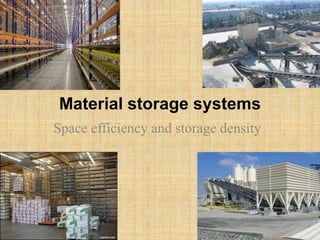
Presentation6
- 1. Material storage systems Space efficiency and storage density
- 2. • Storage is an important consideration for every business however small or large. • This includes space for – Product storage, – Employee, – Manufacturing plant & – Documentation. • Using space efficiently makes the business more effective.
- 3. Unit load storage • Unit load is constructed by bringing together a no. of individual items of identical configuration to make a large load, which ensures convenience during storage and transportation. • Methods: – Pallet – Skid – Slip-sheet – Clamp-load
- 4. • Skid Method:- Another method is to construct a platform to fit the load, which is known as skid. Skids are used for non-standard loads such as long metal components or in compressor/generator assembly. • Pallet Method:- The most commonly used method is to buid load on a raised platform, which is known as Pallet. The pallets are of standard size and used for standard loads.
- 5. • Slip-sheet:- The slip sheet is the platform on which the load is assembled. • Clamp load:- The clamp is load assembly on the floor with clamps on 4 sides of the load for facilitating its movement using material handling equipment.
- 6. Storage principles • The storage system is a warehouse has an important role to play in the total cost and success of warehousing operations. • Efficient use of material handling equipment is possible provided the storage system allows easy access of storage and retrieval of inventory. • Maximum utilization of the available space • Need for easy and quick access to stored goods.
- 7. Rules in designing effective storage systems • Minimisation of travel distance • Maximising utilisation of available space • Providing easy and quick access to stored goods • Facilitation of easy tracking of material • Provision of security against fire,damage and theft • Prevention of contamination and deterioration of goods
- 8. Criteria for selecting a storage system • Product characteristics • Configuration • Shelf life • Product variety
- 9. Benefits of storage design • Space economics • Enhance throughput • Ease in material location and tracking • Security, safety and housekeeping
- 10. Storage methods
- 11. Block storage • The most simple type of storage method and does not attract any financial investments. • Boxes, cartons or sacks containing the material are stored in spread or stacked form in the area assigned for storge.
- 12. Racking system • Racks are used for storage of items that are longer, apart from small containers, boxes, pallets etc. • When the weight of unit loads are beyond human handling capacity, mechanical mateiral handling equipment are normally used for storage and retrieval operations. • Two types – Stationary – Portable
- 13. Shelving system • These system are in use for non-palletised or non-uniform types of load. • The material is stored and retrieved in the shelf by hand. • The shelves are closed or open type, depending on the product configuration • Shelving is the most flexible and cost effective storage structure, which is available in modular configurations to suit various storage volumes and product configurations.
- 14. Pallets • These are specially designed platforms for storage of goods with a view to the whole load being moved by fork lift, wherever it is required. • These are widely used in-house material handling system. • Pallets can be broadly classified into two groups – Sturdy, multiple reusable pallets – One way non-returnable pallets
- 15. Containers • Containers are most commonly used in manufacturing plants for in-process material handling applications. • The different types of containers commonly used are:
- 16. Welded wire containers – These are light in weight, self-cleaning , make it possible to view the material and allow ventilation. – These containers can be stacked one above the other and ensure uniform weight for movement.
- 17. Corrugated metal containers – They are used in the engineering industry where high strength and very high damage resistance features are required to handle heavy metal parts.
- 18. Plastic containers – These are moulded polymer construction, similar to metal containers used for material storage, handling and shipping. – They are light in weight and can be cleaned.
- 19. Automatic storage and retrieval system (ASRS) – Warehouses designed for high risk storage , due space constraints, and operating on a high throughput rate use the ASRS along with an automated material handling system.
- 20. Bulk storage-silos – These are basically used for bulk storage of materials like cement, food – grains and fertilisers.
